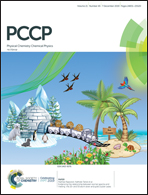Proximate stochastic chiral symmetry breaking is mechanically tunable: formation of enantiomeric hetero-double-helices and aggregates from racemic oxymethylenehelicene oligomers†
Abstract
A mixture of oxymethylenehelicene (P)-hexamer and (M)-hexamer in solution exhibited chiral symmetry breaking, which was induced by mechanical stirring, during the formation of enantiomeric hetero-double-helices and their aggregates. A racemic 50 : 50 mixture was heated to 90 °C to form a dissociated state, and then cooled to 25 °C. Mechanical stirring with a magnetic stirrer at 2000 rpm for 100 h resulted in the exhibition of a strong negative Cotton effect at 322 nm. Repeated experiments provided negative Cotton effects, which is due to the deterministic chiral symmetry breaking. No change in the Cotton effect occurred in the absence of stirring. The (P)-hexamer to (M)-hexamer mixing molar fraction was varied, and a positive Cotton effect appeared at molar fractions between 40 : 60 and 46 : 54 and a negative Cotton effect at molar fractions between 48 : 52 and 60 : 40, which was reversed at 47 : 53. The slight deviation of symmetry from that at 50 : 50 was termed proximate stochastic chiral symmetry breaking. The process of chiral symmetry breaking could be tuned by varying the procedures of mechanical stirring and mixing procedures for solutions of (P)-hexamer and/or (M)-hexamer.



 Please wait while we load your content...
Please wait while we load your content...